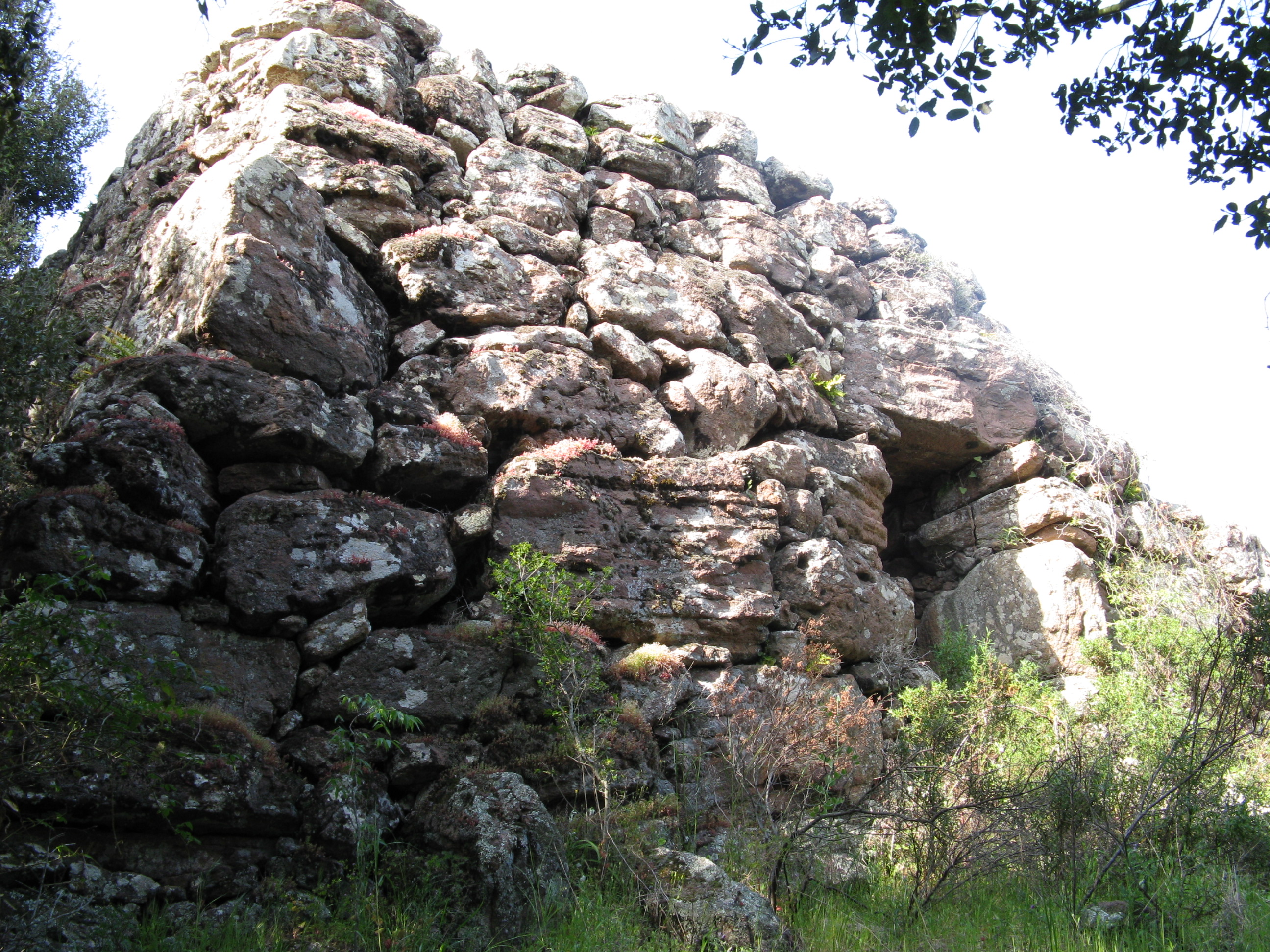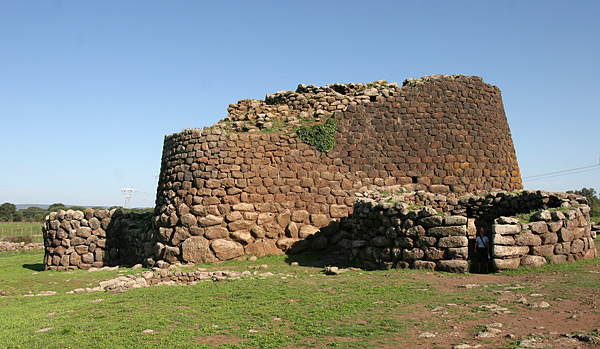|
Protonuraghi
A protonuraghe is a style of megalithic building dating from the first half of the 2nd millennium BC that precedes the classical nuraghe in Sardinia. Of the approximately 7,000 nuraghes, only 300 belong to this type.Paolo Melis''Civiltà nuragica'' Delfino editore, Sassari, 2003, . Description Also called "pseudonuraghes" or "corridor nuraghes", the protonuraghes were built between 1700 and 1500 BC, during the transition period between the Bonnanaro culture The Bonnanaro culture is a protohistoric culture that flourished in Sardinia during the 2nd millennium BC (1800–1600 BC), considered to be the first stage of the Nuragic civilization. It takes its name from the comune of Bonnanaro in the provinc ... (A2 phase, '' Sant'Iroxi '') and the Sub-Bonnannaro culture (facies of ''Sa turricula''). They differ significantly from the classical nuraghes for their stockier look and their generally irregular plan and because they are not provided with the large circular room, typical of t ... [...More Info...] [...Related Items...] OR: [Wikipedia] [Google] [Baidu] |
Bonnanaro Culture
The Bonnanaro culture is a protohistoric culture that flourished in Sardinia during the 2nd millennium BC (1800–1600 BC), considered to be the first stage of the Nuragic civilization. It takes its name from the comune of Bonnanaro in the province of Sassari where in 1889 the eponymous site was discovered. Chronology The Bonnanaro culture is divided chronologically into two main phases: Origin According to Giovanni Lilliu the people who produced this culture probably originated in Central Europe and the Polada culture area. From a material culture point of view, the Bonnanaro culture shows influences of the preceding pan-European Bell Beaker culture, the post-Beaker (''epicampaniforme'') Polada culture from northern Italy, the Remedello culture, Rinaldone culture and El Argar culture. M.Perra (1997) theorizes a season of conflict between the Chalcolithic natives and the groups of Beaker heritage which caused a general involution, typical of this historical phase. Descriptio ... [...More Info...] [...Related Items...] OR: [Wikipedia] [Google] [Baidu] |
NURAGHE FRONTE ^^39,E MOLA - Panoramio
The nuraghe (, ; plural: Logudorese Sardinian , Campidanese Sardinian , Italian ), or also nurhag in English, is the main type of ancient megalithic edifice found in Sardinia, developed during the Nuragic Age between 1900 and 730 B.C. Today it has come to be the symbol of Sardinia and its distinctive culture known as the Nuragic civilization. More than 7,000 nuraghes have been found, though archeologists believe that originally there were more than 10,000. Etymology According to the ''Oxford English Dictionary'' the etymology is "uncertain and disputed": "The word is perhaps related to the Sardinian place names ''Nurra'', ''Nurri'', ''Nurru'', and to Sardinian ''nurra'' 'heap of stones, cavity in earth' (although these senses are difficult to reconcile). A connection with the Semitic base of Arabic ''nūr'' 'light, fire, etc.' is now generally rejected." The Latin word ''murus'' ('wall') may be related to it, being a result of the derivation: ''murus''–''*muraghe''–n ... [...More Info...] [...Related Items...] OR: [Wikipedia] [Google] [Baidu] |
Megalithic
A megalith is a large stone that has been used to construct a prehistoric structure or monument, either alone or together with other stones. There are over 35,000 in Europe alone, located widely from Sweden to the Mediterranean sea. The word was first used in 1849 by the British antiquarian Algernon Herbert in reference to Stonehenge and derives from the Ancient Greek words "mega" for great and "lithos" for stone. Most extant megaliths were erected between the Neolithic period (although earlier Mesolithic examples are known) through the Chalcolithic period and into the Bronze Age. At that time, the beliefs that developed were dynamism and animism, because Indonesia experienced the megalithic age or the great stone age in 2100 to 4000 BC. So that humans ancient tribe worship certain objects that are considered to have supernatural powers. Some relics of the megalithic era are menhirs (stone monuments) and dolmens (stone tables). Types and definitions While "megalith" is ... [...More Info...] [...Related Items...] OR: [Wikipedia] [Google] [Baidu] |
2nd Millennium BC
The 2nd millennium BC spanned the years 2000 BC to 1001 BC. In the Ancient Near East, it marks the transition from the Middle to the Late Bronze Age. The Ancient Near Eastern cultures are well within the historical era: The first half of the millennium is dominated by the Middle Kingdom of Egypt and Babylonia. The alphabet develops. At the center of the millennium, a new order emerges with Mycenaean Greek dominance of the Aegean and the rise of the Hittite Empire. The end of the millennium sees the Bronze Age collapse and the transition to the Iron Age. Other regions of the world are still in the prehistoric period. In Europe, the Beaker culture introduces the Bronze Age, presumably associated with Indo-European expansion. The Indo-Iranian expansion reaches the Iranian plateau and onto the Indian subcontinent (Vedic India), propagating the use of the chariot. Mesoamerica enters the Pre-Classic (Olmec) period. North America is in the late Archaic stage. In Maritime Southeast ... [...More Info...] [...Related Items...] OR: [Wikipedia] [Google] [Baidu] |
Nuraghe
The nuraghe (, ; plural: Logudorese Sardinian , Campidanese Sardinian , Italian ), or also nurhag in English, is the main type of ancient megalithic edifice found in Sardinia, developed during the Nuragic Age between 1900 and 730 B.C. Today it has come to be the symbol of Sardinia and its distinctive culture known as the Nuragic civilization. More than 7,000 nuraghes have been found, though archeologists believe that originally there were more than 10,000. Etymology According to the ''Oxford English Dictionary'' the etymology is "uncertain and disputed": "The word is perhaps related to the Sardinian place names ''Nurra'', ''Nurri'', ''Nurru'', and to Sardinian ''nurra'' 'heap of stones, cavity in earth' (although these senses are difficult to reconcile). A connection with the Semitic base of Arabic ''nūr'' 'light, fire, etc.' is now generally rejected." The Latin word ''murus'' ('wall') may be related to it, being a result of the derivation: ''murus''–''*muraghe''–n ... [...More Info...] [...Related Items...] OR: [Wikipedia] [Google] [Baidu] |
Sardinia
Sardinia ( ; it, Sardegna, label=Italian, Corsican and Tabarchino ; sc, Sardigna , sdc, Sardhigna; french: Sardaigne; sdn, Saldigna; ca, Sardenya, label=Algherese and Catalan) is the second-largest island in the Mediterranean Sea, after Sicily, and one of the 20 regions of Italy. It is located west of the Italian Peninsula, north of Tunisia and immediately south of the French island of Corsica. It is one of the five Italian regions with some degree of domestic autonomy being granted by a special statute. Its official name, Autonomous Region of Sardinia, is bilingual in Italian and Sardinian: / . It is divided into four provinces and a metropolitan city. The capital of the region of Sardinia — and its largest city — is Cagliari. Sardinia's indigenous language and Algherese Catalan are referred to by both the regional and national law as two of Italy's twelve officially recognized linguistic minorities, albeit gravely endangered, while the regional law provides ... [...More Info...] [...Related Items...] OR: [Wikipedia] [Google] [Baidu] |
Archaeology Of Sardinia
Archaeology or archeology is the scientific study of human activity through the recovery and analysis of material culture. The archaeological record consists of artifacts, architecture, biofacts or ecofacts, sites, and cultural landscapes. Archaeology can be considered both a social science and a branch of the humanities. It is usually considered an independent academic discipline, but may also be classified as part of anthropology (in North America – the four-field approach), history or geography. Archaeologists study human prehistory and history, from the development of the first stone tools at Lomekwi in East Africa 3.3 million years ago up until recent decades. Archaeology is distinct from palaeontology, which is the study of fossil remains. Archaeology is particularly important for learning about prehistoric societies, for which, by definition, there are no written records. Prehistory includes over 99% of the human past, from the Paleolithic until the advent of ... [...More Info...] [...Related Items...] OR: [Wikipedia] [Google] [Baidu] |
Types Of Monuments And Memorials
Type may refer to: Science and technology Computing * Typing, producing text via a keyboard, typewriter, etc. * Data type, collection of values used for computations. * File type * TYPE (DOS command), a command to display contents of a file. * Type (Unix), a command in POSIX shells that gives information about commands. * Type safety, the extent to which a programming language discourages or prevents type errors. * Type system, defines a programming language's response to data types. Mathematics * Type (model theory) * Type theory, basis for the study of type systems * Arity or type, the number of operands a function takes * Type, any proposition or set in the intuitionistic type theory * Type, of an entire function ** Exponential type Biology * Type (biology), which fixes a scientific name to a taxon * Dog type, categorization by use or function of domestic dogs Lettering * Type is a design concept for lettering used in typography which helped bring about modern textual printin ... [...More Info...] [...Related Items...] OR: [Wikipedia] [Google] [Baidu] |
Buildings And Structures In Sardinia
A building, or edifice, is an enclosed structure with a roof and walls standing more or less permanently in one place, such as a house or factory (although there's also portable buildings). Buildings come in a variety of sizes, shapes, and functions, and have been adapted throughout history for a wide number of factors, from building materials available, to weather conditions, land prices, ground conditions, specific uses, prestige, and aesthetic reasons. To better understand the term ''building'' compare the list of nonbuilding structures. Buildings serve several societal needs – primarily as shelter from weather, security, living space, privacy, to store belongings, and to comfortably live and work. A building as a shelter represents a physical division of the human habitat (a place of comfort and safety) and the ''outside'' (a place that at times may be harsh and harmful). Ever since the first cave paintings, buildings have also become objects or canvasses of much artistic ... [...More Info...] [...Related Items...] OR: [Wikipedia] [Google] [Baidu] |
Megalithic Monuments In Italy
A megalith is a large stone that has been used to construct a prehistoric structure or monument, either alone or together with other stones. There are over 35,000 in Europe alone, located widely from Sweden to the Mediterranean sea. The word was first used in 1849 by the British antiquarian Algernon Herbert in reference to Stonehenge and derives from the Ancient Greek words "mega" for great and "lithos" for stone. Most extant megaliths were erected between the Neolithic period (although earlier Mesolithic examples are known) through the Chalcolithic period and into the Bronze Age. At that time, the beliefs that developed were dynamism and animism, because Indonesia experienced the megalithic age or the great stone age in 2100 to 4000 BC. So that humans ancient tribe worship certain objects that are considered to have supernatural powers. Some relics of the megalithic era are menhirs (stone monuments) and dolmens (stone tables). Types and definitions While "megalith" is ... [...More Info...] [...Related Items...] OR: [Wikipedia] [Google] [Baidu] |





.jpg)

